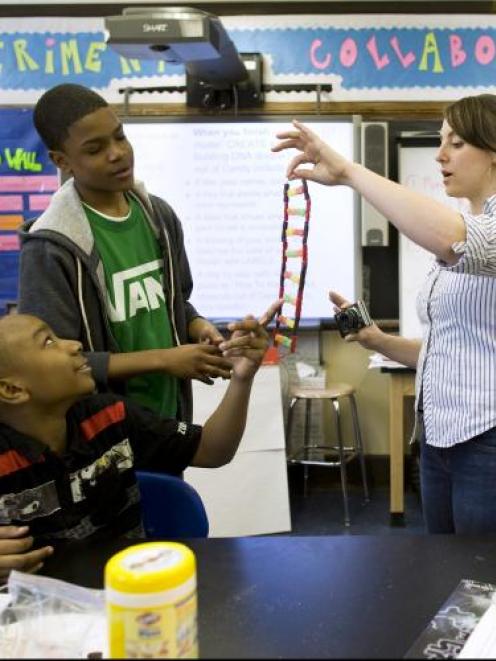
Quest to Learn was designed to be different from the ground up. This complete reinvention of the typical urban middle school downplays rote memorization in favor of collaborative learning, critical thinking and imaginative exploration as a way to change how today's students learn.
And this fall, it's coming to Chicago
With more than $US1.2 million ($1.5 million) in funding from the MacArthur Foundation and other philanthropic organisations, the public charter school to be called Chicago Quest is scheduled to open in September in a renovated school building on the edge of the old Cabrini Green housing project. Officials are already talking about one day opening Chicago Quests on the city's South and West Sides as well.
For city educators, Chicago Quest is an important foray into 21st century thinking. Pupils will learn from video game designers and computer experts how to design and build their own video games, produce custom websites, podcast, blog, record and edit short films and connect with technology in a way that is both meaningful and productive.
In an era of rigid standardised testing, city leaders say Quest is a novel approach to get today's wired 11-, 12- and 13-year-olds prepared for the technology-driven, global job market that awaits them.
"The only way we're going to catch up with the rest of the world is to re-invent how teaching and learning occurs," said Chicago Public Schools interim chief Terry Mazany.
"That's why this is so vital. It's going to be an innovation engine for the district, and I'll strongly encourage the next leadership to keep them close and learn from them."
On a recent trip to the cramped Manhattan headquarters, Elizabeth Purvis, executive director of Chicago International Charter School, seemed dazzled by what pupils were able to do.
"You can't watch how these kids work, how invested they are in what they're learning, and not come away amazed," Purvis said.
Chicago International Charter School, the city's largest network of charters with 13 campuses and more than 8000 pupils, will operate Chicago Quest, which is expected to debut with about 300 6th and 7th graders for the 2011-12 school year. Pupils will be selected in a citywide lottery, ensuring a diverse population of boys and girls and pupils from all economic backgrounds. The school, like all CICS charters, will not have tuition fees.
While Quest's concept and framework will come from New York, organisers in Chicago will tap into the area's deep talent pool for teachers and game designers to give it a distinct local flavour, Purvis says.
Some parts of the curriculum will be different, and lesson plans will try to align with state testing requirements. But the big-picture idea of using technology and gaming to inspire collaborative learning will be critical to the mission.
"The reality is, we are a Chicago Public School," Purvis said. "So our (testing) scores matter. We're not going to say, as long as everyone is happy and the teachers think we're doing well, it's a good school. That's the furthest from the truth. The goal is hoping that we see accelerated performance in here."
What's most remarkable about New York's 2-year-old Quest to Learn isn't the technology, although it's impressive. It's that the pupils, while computer savvy, are for the most part ordinary pre-teens, said Bob Holling, a design strategist with the Institute of Play, a New York-based nonprofit research organisation that launched Quest to Learn.
"These students are not tech whizzes, not all of them," Holling said. "That said, they're of the generation that has grown up around technology."
That forms the basis of education at Quest to Learn.
One day recently, a dozen pupils filed into a classroom where a ceiling-mounted video projector was showing the image of a computer screen onto a large white gym mat on the floor. The computer-generated image consisted of two sandy banks, representing the ancient civilisations of Egypt and Mesopotamia, bisected by a fast-moving river.
Four pupils knelt beside the river, pulling out computer images of stone tablets and papyrus, mud-brick arches and pottery, with water-bottle-sized game controllers whose movements were tracked by wall-mounted infrared cameras.
The pupils had already studied the differences between the societies of ancient Egypt and Mesopotamia with reading materials, a film and a trip to a local history museum.
But the lesson on this day - demanding split-second decisions about which relics belong to which society and why - had the pupils transfixed in a way teachers at more traditional schools might only dream about.
"It's a different type of learning because of how they teach it, not what they're teaching," said 6th grader Connor Fitzgerald. "They give you the facts, but more importantly they tell you about the relationships between those facts."
That same day, 7th grader Isabel Clements was taking what she had learned in a lecture on genetics to create a computer-generated model of a different species of butterfly that could withstand life in a harsh new habitat of her choosing. A professional design firm hopes to use some of the class' creations in an evolution-themed video game.
"We've tried really, really hard to hold true to our vision," said Katie Salen, a game designer and professor at an acclaimed art, design and technology college in New York, who co-founded Quest to Learn. "And so we haven't varied at all from the big, important ideas."
Those "big, important ideas" include a unique grading system that does away with traditional "A", "B" and "C" and, instead, has pupils competing, in video game speak, to earn levels of expertise such as "senior", "apprentice", "novice" and "master."
Pupils learn to help each other improve.
Gaming is central to the school's make-up, instructors say, because it provides the ideal platform for creativity, imagination and critique. It also creates an arena for learning where pupils expect to sometimes fall short, Salen said.
"One of things about gaming is that resilience is sometimes more important than ability, and that you can have kids with high ability who aren't that resilient and won't try and try and try again, and you may have kids with lower ability but their resilience is high and they may master the game," Purvis said.
"What they're really teaching these kids are 21st century collaboration, problem solving and critical thinking."
Purvis admits it's probably too early to tell if the type of learning in practice at Quest to Learn better prepares pupils for college or even for high school. The ultimate goal, Salen said, is not necessarily to produce more Quest to Learns around the country, but rather to apply some of its most successful concepts to traditional schools.
That, she said, may be the school's most enduring legacy.
"The vision is to try to help schools make the changes they want to make, to adopt as much or as little as makes sense for them," Salen said. "I think there is a little something here for everybody."












